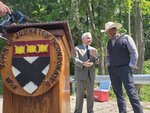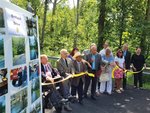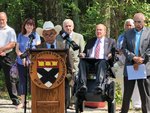





Flooding in 2010 and again in 2018 cut some Belfield Drive residents off from civilization.
As the Pocasset River swelled past its banks, Johnston Mayor Joseph M. Polisena reached some of his constituents by water.
A sign hung at a press conference on Monday, featuring a photograph from past floods, showing Polisena talking on the phone, traveling across floodwaters in a boat.
Hopefully, if floodplain improvements on Belfield Drive work, Polisena will only need a car to travel down the road after future storms.
Members of the Johnston Town Council joined representatives from the United States Department of Agriculture, the Northern Rhode Island Conservation District, U.S. Sen. Jack Reed (D-Rhode Island), U.S. Rep. James Langevin (D-Rhode Island), and state Rep. Deborah Fellela (D-Johnston), at an event near 68 Belfield Drive, to celebrate the completion of a floodplain restoration project, aimed at eliminating future flooding.
“This is truly a special day,” Polisena said from behind a lectern bearing the town seal. “This is how it works; how it’s supposed to work.”
Polisena described past flood events as “horrific public safety disasters.”
Federal funding for the project was provided through the USDA Emergency Watershed Protection (EWP) program.
“EWP authorizes the USDA Natural Resources Conservation Service (NRCS) to purchase permanent easements on eligible lands and restore the floodplain functions in the easement area to their natural conditions,” according to an agency press release. “Participation in the EWP Floodplain Easements program is voluntary.”
Polisena happily volunteered a soggy section of Johnston for EWP assistance.
“Otherwise we’d be wearing hip boots and a personal floatation device,” he joked, as he introduced the completed work, and praised the partnership between local, state and federal government officials.
“NRCS entered into an agreement with the Rhode Island Association of Conservation Districts (RIACD), which accepted applications from eligible landowners, secured appraisals and acquired land,” according to a USDA press release. “Restoration work included both structural and non-structural measures to bring back floodplain functions.”
A house once stood at 68 Belfield Drive, but was purchased and demolished.
“A structure was removed to create a flood water storage area, then a box culvert was installed to allow storm water to flow under the road and back into the Pocasset River,” according to the USDA. “Native vegetation was planted to control soil erosion.”
The gathered officials marked completion of the floodplain restoration project with a ribbon cutting ceremony.
“Belfield Drive terminates in a cul-de-sac and, therefore, residents have only one means of egress,” according to the USDA. “The roadway experienced recurring flooding from the Pocasset River that made the road impassible.”
The EWP program is intended to help communities, like Johnston, quickly address serious and long-lasting damages to infrastructure caused by natural disasters.
“Restoration included both structural and non-structural measures to bring back floodplain functions such as water storage and flow, control erosion, and establish native vegetation,” according to the USDA. “Major elements of the project included raising the roadway at Belfield Drive to allow for safe access along the public right-of-way during flood events and demolition of a single-family residence that experienced recurrent flooding. These elements were designed to lessen flood conditions in the future.”
Cassius Spears, President of the Rhode Island Association of Conservation Districts, Phou Vongkhamdy, Rhode Island State Conservationist with the USDA Natural Resources Conservation Service (NRCS), and Richard Went, Chairman of the Northern Rhode Island Conservation District, attended the event, providing context to the changes made to Belfield Drive.
“Floodplains can provide significant protection from flood damage to downstream landowners,” Vongkhamdy said. “The purpose of this project was to limit future uses of land in this floodplain area to make it available to store flood water.”
Both men were instrumental in the project, according to Polisena, and Gina DeMarco, District Manager for the Northern Rhode Island Conservation District.
Polisena thanked DeMarco for her leadership, and credited her for seeing the flood plain restoration through to fruition.
“Gina was unbelievable,” Polisena said. “Gina tested me like no other woman has tested me.”
Unlike other emergency assistance programs, the EWP “does not require a disaster declaration by federal or state government officials for program assistance to begin,” according to the USDA.
“The people who lived here were constantly, literally under water,” Reed said, adding that with climate change, “more communities will be under water.”
Went said the floodplain is designed to combat a 100-year storm, but not a 500-year event, like the 2010 flood.
Only land in the affected section of Belfield Drive qualified for EWP work. This section of the road met the prerequisite criteria for help through the program: it had been damaged by flooding at least once in the previous calendar year, and had been subject to flood damage at least twice within the past decade.
“The NRCS State Conservationist can declare a local watershed emergency and initiate EWP assistance in cooperation with an eligible sponsor,” according to the USDA. “Funded projects must demonstrate they reduce threats to life and property; be economically, environmentally and socially sound; and must be designed to acceptable engineering standards, if applicable.”
A yellow ribbon was strung across Belfield Drive, and Polisena cut it with a giant pair of scissors.
“We finally got it across the finish line,” Langevin said. “This is what investing in infrastructure is all about.”
Comments
No comments on this item Please log in to comment by clicking here